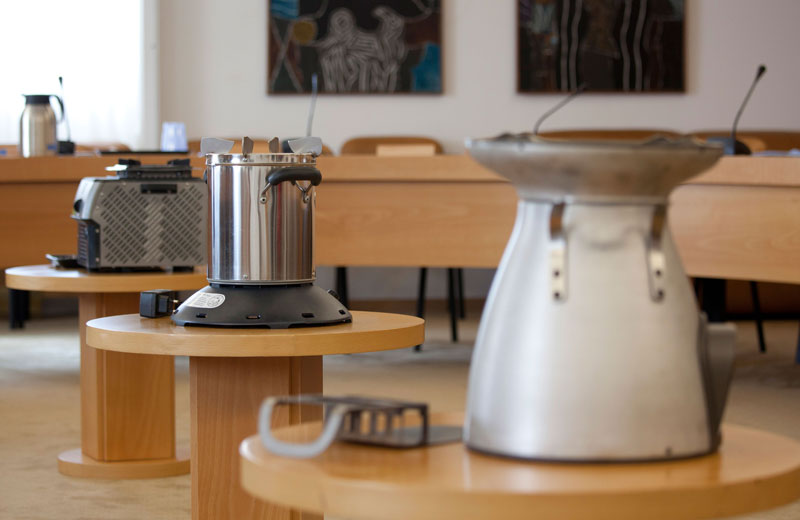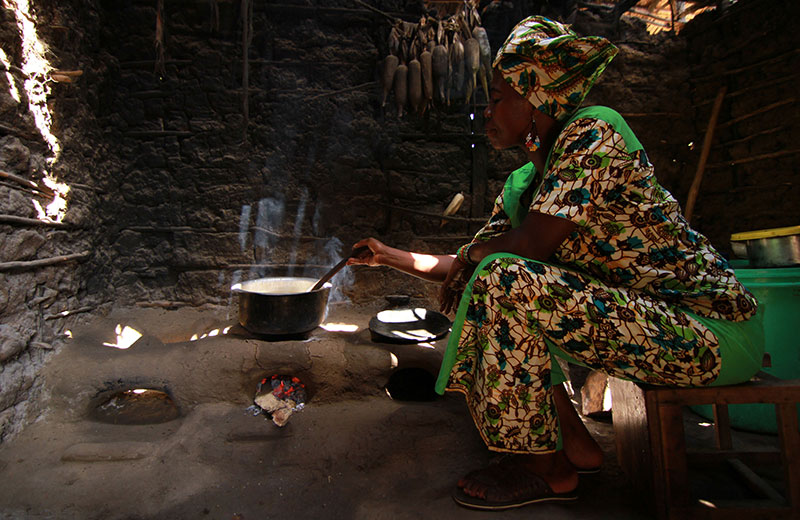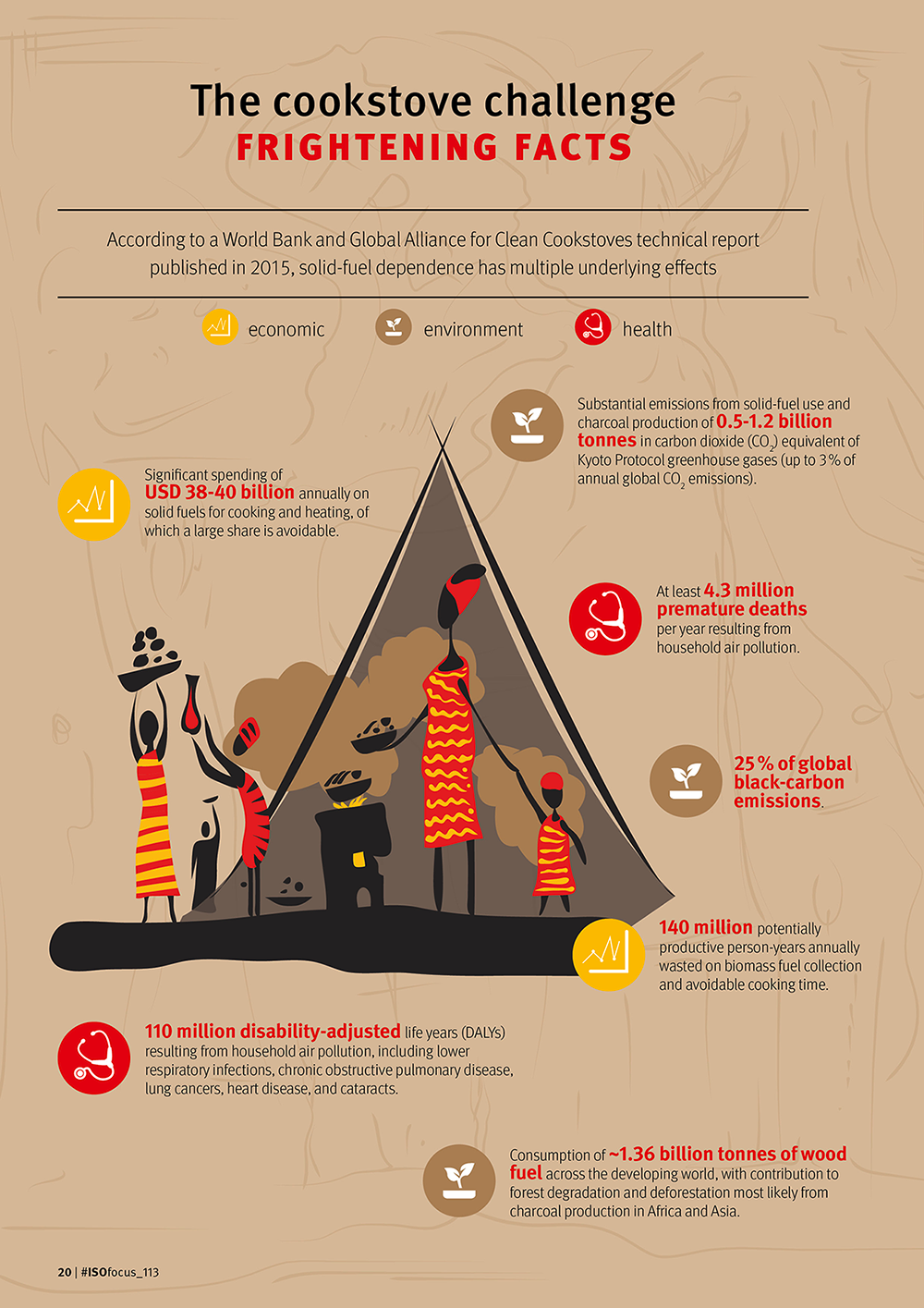Cooking the family meal can be dangerous for poor people in developing countries. Indeed, a 2015 World Health Organization (WHO) report estimates that exposure to smoke from the simple act of cooking constitutes the fourth leading risk factor for disease in developing countries, and causes more than four million premature deaths per year – exceeding deaths attributable to malaria or tuberculosis. In addition, tens of millions more fall sick with illnesses that could readily be prevented with the adoption of clean and efficient cookstoves and fuels. What’s more, emissions due to cooking with biomass are a significant contributor to climate change.
Could standards be the solution? According to Dr. Ranyee Chiang, Director of Standards, Technology and Fuels at the Global Alliance for Clean Cookstoves and Chair of ISO technical committee ISO/TC 285, Cookstoves and clean cooking solutions, standards can help provide rigorous definitions and goals for emissions (relevant for climate and health), efficiency, safety, durability and quality.
A critical first step
The Global Alliance for Clean Cookstoves, a public-private partnership hosted by the United Nations Foundation and comprising over 1 300 partners, was launched to coordinate an international approach to build a robust market for clean cookstoves. The Global Alliance’s partnership with ISO seemed an important platform to develop and apply standards to ensure the best possible cookstoves and fuels are available in the market.
In February 2012, more than 90 stakeholders from 23 countries met in The Hague, Netherlands, for an ISO meeting that resulted in unanimous support among participants for an International Workshop Agreement (IWA 11:2012), which defines tiers of performance for efficiency, emissions and safety. The workshop was organized by the Global Alliance and the Partnership for Clean Indoor Air (PCIA), with the American National Standards Institute (ANSI) as the secretariat.
To update these initial IWA guidelines and establish them as International Standards, ISO created ISO/TC 285 in 2013. Kenya, through the Kenya Bureau of Standards (KEBS), and the USA, through the American National Standards Institute (ANSI), are serving as co-secretariats of the committee.
S. Joe Bhatia, ANSI President and CEO, comments: “We can’t imagine a more critical issue than the health and safety of millions of people around the world. We are proud to play a leadership role in the efforts to assure the safety of cookstoves, and look forward to the tremendous impact this global partnership can achieve.”
ISO/TC 285 provides governments, industry and organizations around the world with the opportunity to become involved in the process of designing, implementing and updating standards dealing with this critical topic.
In addition to the emissions and efficiency performance of the stove, the committee is looking at the following factors:
- Harmonized methodology, indicators and reporting – Facilitating international collaboration and trade
- Local cooking habits – Matching laboratory testing to users’ cultural and practical habits and available fuels
- Safety – Is it safe to use in the proximity of children and the whole family?
- Durability – The stove needs to be durable and easy to maintain
- Field testing – Guidelines for testing cookstoves and fuels performance and use in real-life settings
- Social impacts – Guidance on how to assess social impacts like time savings, gender impacts and livelihood impacts
Currently, there are four working groups (WGs) focusing on the development of standards and other essential documents in subject areas associated with cookstoves and fuels. Those WGs are: WG 1, Conceptual framework; WG 2, Lab testing methods; WG 3, Field testing methods, and WG 4, Social impacts. The standards being developed will be used to set government regulations, support donor and investment decisions and drive manufacturers to improve their technologies.

Getting developing countries on board
As of the end of 2015, the committee comprised 25 participating countries, 15 observing countries and eight international external liaisons organizations, including WHO. Increasing participation – particularly from developing countries – is a big priority for the Global Alliance’s Ranyee Chiang, who believes their contributions are vital for the adoption of standards that can strengthen the nascent cookstoves and fuels market.
“There are so many different ways to cook, and foods to eat,” says Ranyee. “Standards need to address performance, but we need to make sure technology options fit into the cultural context and can be used with available resources.” In most rural homes, a stove can be an open fire and the fuel as basic as wood, dried animal dung or agricultural residue, together known as “biomass” fuels.
In Honduras, Victoria Cortés, an Associate Professor at the Regional Testing and Knowledge Center (RTKC) at Zamorano University in Tegucigalpa, who aims to strengthen the national outreach programmes and adoption of clean cookstove technologies, says it’s essential to participate in the work of ISO/TC 285.
“Being part of ISO/TC 285 enables the RTKC to contribute to the creation of standards based on technologies used in the region, for example the plancha (griddle) cookstoves,” explains Victoria. “We are participating in the ISO standards work helping to establish guidelines on the rating and evaluation of cookstove models, to encourage positive innovations based on health, environmental and technical issues.”
For the Regional Testing and Knowledge Center at Zamorano, ISO/TC 285 standards will enable the Center to provide high-quality assessments and contribute to the dissemination of efficient and optimum models on the national and regional market, based on reliable and tested performance.

Where there’s hope…
While the challenges are daunting, there are now good reasons to believe the next decade will be a transformative period for the global cookstoves and fuels sector. Broader access to cleaner, more efficient cooking solutions is within closer reach thanks to the work being done by ISO/TC 285.
That leads to the next challenge – developing a global cookstoves and fuels industry that is constantly innovating to improve design and performance, while improving affordability and access to the best possible technologies.
Clearly, there is still a lot to be done. ISO/TC 285 needs more countries who are actively collaborating on standards development and implementing policies to change the reliance on solid fuels and inefficient, polluting cookstoves that come at a huge human cost.
So as we applaud the Global Alliance’s ambitious goal of getting 100 million homes to adopt clean and/or efficient stoves and fuels by the year 2020, and the determination of ISO/TC 285 to provide solutions that will spur confidence among stakeholders, let’s us be hopeful that the next five years will enable half of the world to cook safely.


